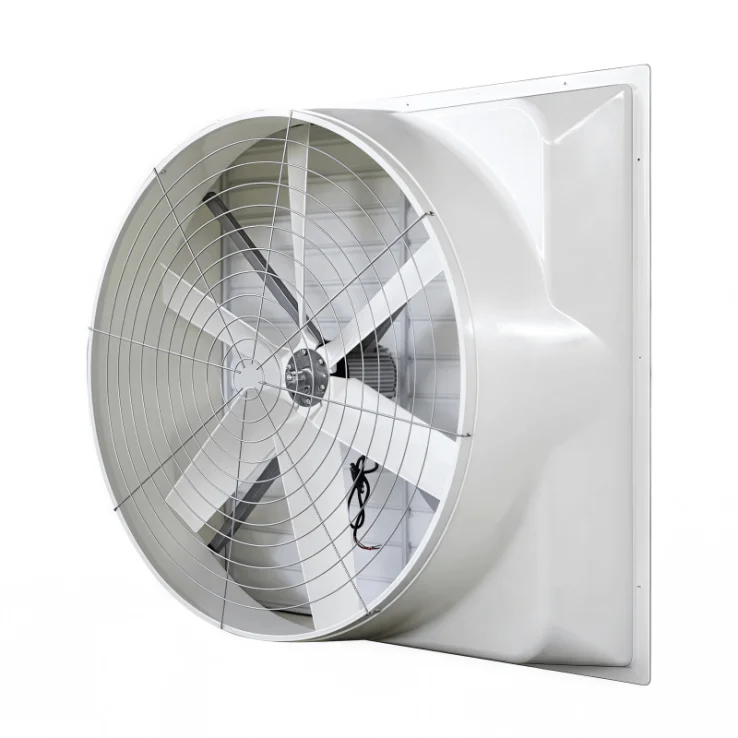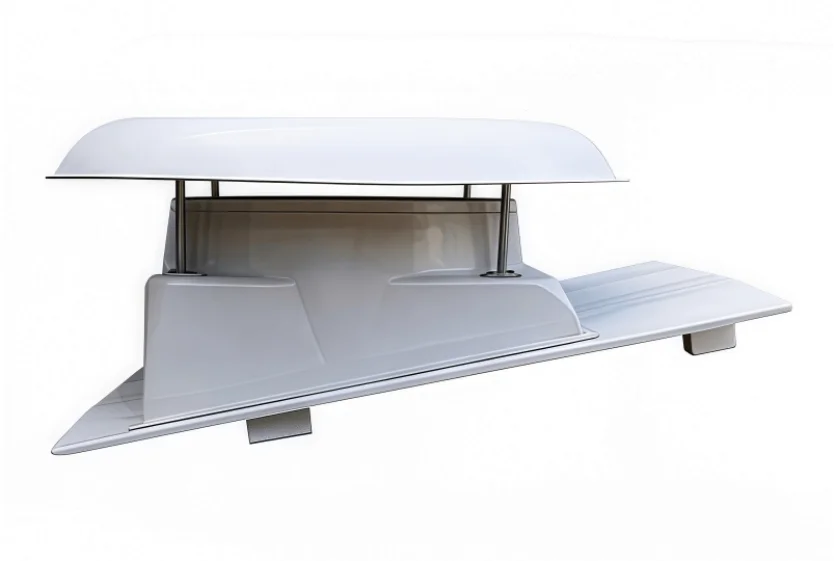Industrial Fans and Ventilation: Wall Mount vs. Roof Mount

Overview of Industrial Ventilation Systems
Industrial and agricultural spaces need strong ventilation systems to keep air clean, control temperature, and ensure safety for people, animals, and machines. In enclosed or partly enclosed places like barns, warehouses, or factories, bad airflow can cause heat to build up, harmful gases to collect, and moisture to damage structures or health.
Importance of Proper Airflow in Industrial and Agricultural Environments
Ventilation is more than just comfort—it’s vital for controlling the environment. In livestock barns, good airflow removes extra heat, ammonia, carbon dioxide, and dampness produced by animals. In factories or storage buildings, it helps clear fumes, keeps temperatures steady, and stops machines from getting too hot. Without enough ventilation, air inside can become stale and unsafe for workers or animals.
Comparing Wall Mount Exhaust Fan and Roof-Mounted Options
When planning a ventilation system for an industrial or agricultural building, a big choice is between wall mount exhaust fans and exhaust fan vents for roof. Each type has special benefits depending on the building’s design and needs.
Structural Differences Between Wall and Roof Installations
Wall exhaust fans are placed on vertical walls at different heights based on the job. These units are often simple to reach for upkeep.
Roof exhaust fans are set on the building’s top to push out hot air that rises naturally. This makes them great for tall buildings where heat gathers near the ceiling.
Installing wall fans usually needs less change to the building than roof systems, which must be sealed against rain and wind.
Performance Considerations in Different Environments
In hot places or buildings with lots of heat, like metal shops or poultry farms, exhaust fan vents for roof work well to pull out rising hot air. However, wall mount exhaust fans give better control over where air moves and can be placed to focus on specific spots in a building. The choice between wall or roof fans depends on whether you need overall ventilation or cooling near machines or animal pens.
Benefits of Using a Wall Mount Exhaust Fan
Wall mount exhaust fans have many practical benefits that make them good for industrial and agricultural settings.
Space-Saving Design and Installation Flexibility
Wall mount exhaust fans don’t take up floor space, which is important in busy places like warehouses or factories. They can be placed at different heights depending on where heat or air needs are. Guangdong Foshan Daiho Equipment Co.,Ltd offers strong wall-mountable industrial exhaust fans with galvanized steel frames that resist rust and provide powerful airflow. These are perfect for places like livestock barns or textile factories.
Airflow Direction Control and Maintenance Accessibility
Another plus is that wall mount exhaust fans can guide air to push out stale air from certain areas or pull in fresh air to specific spots. Also, these fans are easier to clean or fix compared to roof units, which may need ladders or special equipment.
Daiho’s 1460mm fiberglass industrial wall exhaust fan made from durable fiberglass-reinforced plastic (FRP), this fan offers excellent resistance to corrosion, making it ideal for humid and chemical-prone environments. It has an aerodynamic housing that enhances airflow efficiency, automatic louvered shutters to prevent dust ingress, and a protective front grill for added safety. The motor is directly connected to drive, with simple structure and easy maintenance.
Advantages of Installing an Exhaust Fan Vent for Roof
Exhaust fan vents for roof are very effective in large buildings where heat rises and collects.
Effective Heat and Fume Extraction from Upper Zones
Since hot air rises, placing an exhaust fan vent for roof helps it escape easily. This is great for buildings with high ceilings, like greenhouses or airplane hangars, where wall fans may not be enough.
In addition to roof exhaust fans, Daiho’s roof centrifugal ventilators feature aerodynamic blades that enhance upward airflow while reducing wind resistance.These units clear smoke, fumes, humidity, and hot air from overhead spaces.
Enhanced Air Circulation for Large-Scale Facilities
In huge spaces like logistics centers or big poultry houses covering thousands of square meters, exhaust fan vents for roof work with wall inlets or inside circulation fans to create even airflow. Daiho also makes axial flow roof ventilators from aluminum alloy, which are light, durable, and move a lot of air.

Factors to Consider When Choosing Between Wall Mount and Roof Mount Fans
To pick the best system for your building, you need to think about several things together.
Building Layout, Ceiling Height, and Airflow Requirements
A warehouse with low ceilings might do better with wall mount exhaust fans because they’re easier to reach and spread air side to side. But taller buildings benefit more from roof exhaust fan to pull hot air up and out. You also need to decide if you want steady airflow or short bursts based on work schedules or animal needs.
Energy Efficiency, Noise Levels, and Maintenance Demands
Fans use different amounts of energy. Belt-driven models may use less power but need belt changes now and then. Direct-drive fans are more efficient but might be louder depending on speed. Maintenance is also key—roof fans are harder to service because of their height. Daiho offers energy-saving EC motor options and standard AC motor models. Their products meet global standards like ISO9001, ISO14001, CE, ROHS, and CCC.
| Feature | Wall Mount Exhaust Fans | Roof Mount Exhaust Fans |
|---|---|---|
| Installation Location | Mounted on vertical walls | Installed on the roof of the building |
| Airflow Direction | Moves air horizontally across spaces | Pulls hot air upward and out |
| Ideal for | Low to medium-height buildings | Tall buildings with high ceilings |
| Space Efficiency | Saves floor space, can be installed at various heights | Requires space on the roof |
| Maintenance Accessibility | Easier to service from the ground | Requires ladders or scaffolding for access |
| Heat & Fume Extraction | Better for localized cooling near machines or animal pens | Effective for large-scale heat and fume extraction from overhead areas |
| Airflow Control | Can target specific areas for focused airflow | Best for overall temperature and humidity control |
| Energy Efficiency | Generally uses less energy, depending on the type | More energy-efficient options available, but might be louder |
| Maintenance Frequency | Easier and less frequent maintenance | More complex maintenance due to height |
Applications Across Industrial, Agricultural, and Civil Fields
Both wall mount exhaust fans and exhaust fan vents for roof play big roles in many industries, each suited to specific needs.
Use Cases in Livestock Housing, Warehouses, and Manufacturing Plants
In poultry or pig barns, where ammonia and heat need control, using both fan types creates great cross-ventilation. In warehouses storing goods like grains or chemicals that can be harmed by moisture, exhaust fan vents for roof stop dampness near ceilings, while wall mount exhaust fans spread fresh air through aisles.
Factories with fumes, like welding shops, benefit from roof vents pulling air up and wall fans clearing air near workers. Daiho’s circulation fan series helps by boosting inside airflow without adding pressure outside.
Compliance with Safety Standards and Environmental Certifications
Ventilation systems must follow rules for worker safety (OSHA), air quality (IAQ), and fire codes (NFPA). Choosing certified products ensures they’re reliable and meet legal standards in industries like food processing or pharmaceuticals. Guangdong Foshan Daiho Equipment Co.,Ltd has passed ISO9001 and ISO14001 certifications, and many products carry ROHS, CCC, and CE certifications for global quality.
Frequently Asked Questions (FAQ)
What is the main difference between a wall mount exhaust fan and an exhaust fan vent for roof?
A wall mount exhaust fan is placed on walls to move air side to side across spaces. An exhaust fan vent for roof is set on top of buildings to pull out hot air that rises to high areas like attics or tall ceilings.
Which type of fan is better suited for livestock housing?
For livestock like poultry or pigs, where ammonia and heat need control, a mix works best. Wall mount exhaust fans near animals provide cross-ventilation. Exhaust fan vents for roof clear heat from above efficiently.
Are rooftop fans harder to maintain than wall-mounted ones?
Yes. Exhaust fan vents for roof need ladders or scaffolding for access, making upkeep more complex. Wall mount exhaust fans can often be serviced from the ground with simple tools.
Do Daiho’s products meet international safety standards?
Yes. Guangdong Foshan Daiho Equipment Co.,Ltd has passed ISO9001 and ISO14001 certifications. Many products have ROHS, CCC, CE, and EU safety certifications for global standards.
For custom ventilation solutions—from small wall mount exhaust fans to strong exhaust fan vents for roof—contact Guangdong Foshan Daiho Equipment Co.,Ltd.
We focus on designing, making, and selling systems for livestock cooling and heating, including industrial exhaust fans, circulation fans, air coolers, dehumidifiers, and heaters. All are built to global standards. Our 24,000m² factory in Songxia Industrial Park, Foshan, Guangdong, has automated production lines and advanced testing tools to meet your environmental control needs effectively.
